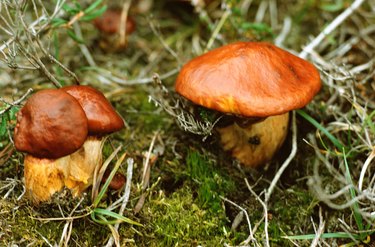Things You'll Need
Sharp knife
Food dehydrator or oven
Mesh or slatted trays
Parchment paper or cheesecloth
Paper towels
Skillet or pot
Resealable freezer containers or bags
Pickling mixture or marinade
Slotted spoon
Silicone or rubber spatula
Sterilized canning jars
Tongs
Large pot of boiling water

Boletus mushrooms are a prize find for mushroom hunters. Imported and domestic boletus mushrooms are often found at grocery stores, often labeled porcini mushrooms. The Boletus family includes the King Cep (Boletus edulis), which is a large, full-bodied mushroom that becomes more intensely flavored when dried. Other types of Boletus might be preserved by drying, freezing or canning.
Drying
Step 1
Pick wild Boletus mushrooms when the weather is dry, to reduce the amount of moisture to be removed during the drying process. Wipe wild and store-bought Boletus mushrooms clean or wash briefly and drain on paper towels. Slice the mushrooms thinly, keeping the slices as uniform as possible.
Video of the Day
Step 2
Line metal mesh trays with parchment paper or cheesecloth. Arrange the mushroom slices on the lined mesh tray or on a wooden, slatted drying tray. Make a single layer and do not let the slices touch one another.
Step 3
Place the tray in the food dehydrator and follow manufacturer's directions for dehydrating the slices. If you have more than one tray of mushrooms in the dehydrator, rotate the top and bottom trays occasionally for more even drying. Dry the mushrooms in a preheated, 140 degree Fahrenheit oven if you do not have a food dehydrator. If you have more than one tray, rotate the top and bottom trays every half hour. Prop the oven door open slightly to allow moisture to escape. Check the mushroom slices every two hours to monitor the drying process.
Step 4
Allow the mushrooms to cool completely and check for any lingering moisture in the slices. Re-process any slices that aren't fully dried. Pack dried mushroom slices in an airtight container or plastic bag.
Freezing
Step 1
Wipe the Boletus mushrooms clean or rinse them quickly and dry on a paper towel. Slice the mushrooms into equal thicknesses, chop into small pieces or leave them whole, as desired.
Step 2
Saute the mushrooms briefly in butter or olive oil or blanch them in a pot of boiling water for about two minutes, remove from the water and drop the mushrooms into cold water. Let the mushrooms cool completely, then dry the blanched mushrooms. Pack the sauteed or blanched mushrooms into airtight freezer bags or containers and freeze.
Step 3
Freeze fresh, raw Boletus mushrooms by simply cleaning and placing them into freezer-safe, airtight containers. Dry the mushrooms with paper towels first, if needed. You can freeze the mushrooms whole, sliced or chopped.
Canning
Step 1
Pour a commercial brining, pickling or marinade solution or a mixture made from your own recipe into a pot and bring to a boil. Drop whole or cut Boletus mushrooms into the boiling mixture. Cook just until the mushrooms are tender.
Step 2
Transfer the hot mushrooms to sterilized canning jars with the slotted spoon. If desired, add additional ingredients such as onions, peppers or garlic. Fill the jars with the pickling brine or marinade solution, leaving one-half inch of space at the top of the jars.
Step 3
Use a silicone or rubber spatula to remove air bubbles, wipe the rims of the jar clean and adjust the lids as needed. Place the jars in a boiling water bath for 20 minutes. Remove the jars from the pot and allow to cool, then tighten down the lids to seal.
Tip
Pack mushrooms in half-pint canning jars. Boletus mushrooms are strongly flavored, so a little goes a long way. Keep the lids loose during the boiling water bath.
Warning
Cooking does not eliminate toxins in poisonous Boletus species. Ensure that you have edible Boletus mushrooms before you handle or eat them. Dried mushrooms might keep up to one year, but discard any that appear moldy or develop an odor. Frozen Boletus mushrooms might be mushy when thawed, so they might be best used in soups, stews and sauces.
Video of the Day
- Mycological Society of San Francisco: Boletus, Leccinum, Suillus
- Colorado State University Extension: Drying Vegetables
- National Center for Home Food Preservation: Marinated Whole Mushrooms
- Gaspe Peninsula's Non-Timber Forest Products: King Bolete or Cep
- Morton Salt: Pickled Mushrooms
- Wayne's Word: Fungi from Palomar Mountain I - Satan's Boletus